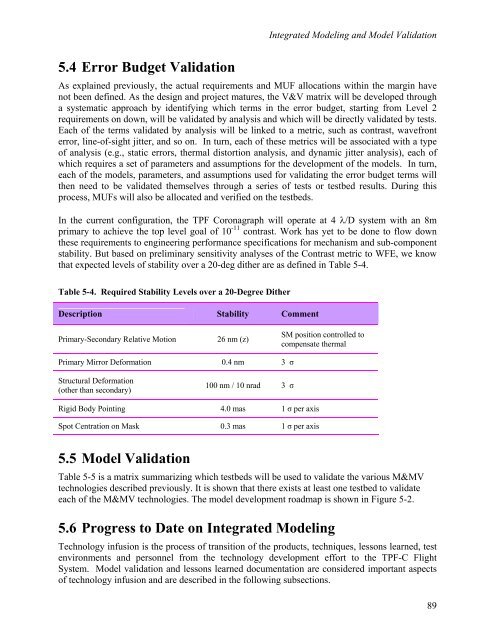TPF-C Technology Plan - Exoplanet Exploration Program - NASA
TPF-C Technology Plan - Exoplanet Exploration Program - NASA
TPF-C Technology Plan - Exoplanet Exploration Program - NASA
Create successful ePaper yourself
Turn your PDF publications into a flip-book with our unique Google optimized e-Paper software.
Integrated Modeling and Model Validation<br />
5.4 Error Budget Validation<br />
As explained previously, the actual requirements and MUF allocations within the margin have<br />
not been defined. As the design and project matures, the V&V matrix will be developed through<br />
a systematic approach by identifying which terms in the error budget, starting from Level 2<br />
requirements on down, will be validated by analysis and which will be directly validated by tests.<br />
Each of the terms validated by analysis will be linked to a metric, such as contrast, wavefront<br />
error, line-of-sight jitter, and so on. In turn, each of these metrics will be associated with a type<br />
of analysis (e.g., static errors, thermal distortion analysis, and dynamic jitter analysis), each of<br />
which requires a set of parameters and assumptions for the development of the models. In turn,<br />
each of the models, parameters, and assumptions used for validating the error budget terms will<br />
then need to be validated themselves through a series of tests or testbed results. During this<br />
process, MUFs will also be allocated and verified on the testbeds.<br />
In the current configuration, the <strong>TPF</strong> Coronagraph will operate at 4 λ/D system with an 8m<br />
primary to achieve the top level goal of 10 -11 contrast. Work has yet to be done to flow down<br />
these requirements to engineering performance specifications for mechanism and sub-component<br />
stability. But based on preliminary sensitivity analyses of the Contrast metric to WFE, we know<br />
that expected levels of stability over a 20-deg dither are as defined in Table 5-4.<br />
Table 5-4. Required Stability Levels over a 20-Degree Dither<br />
Description Stability Comment<br />
Primary-Secondary Relative Motion<br />
26 nm (z)<br />
SM position controlled to<br />
compensate thermal<br />
Primary Mirror Deformation 0.4 nm 3 σ<br />
Structural Deformation<br />
(other than secondary)<br />
100 nm / 10 nrad 3 σ<br />
Rigid Body Pointing 4.0 mas 1 σ per axis<br />
Spot Centration on Mask 0.3 mas 1 σ per axis<br />
5.5 Model Validation<br />
Table 5-5 is a matrix summarizing which testbeds will be used to validate the various M&MV<br />
technologies described previously. It is shown that there exists at least one testbed to validate<br />
each of the M&MV technologies. The model development roadmap is shown in Figure 5-2.<br />
5.6 Progress to Date on Integrated Modeling<br />
<strong>Technology</strong> infusion is the process of transition of the products, techniques, lessons learned, test<br />
environments and personnel from the technology development effort to the <strong>TPF</strong>-C Flight<br />
System. Model validation and lessons learned documentation are considered important aspects<br />
of technology infusion and are described in the following subsections.<br />
89
















